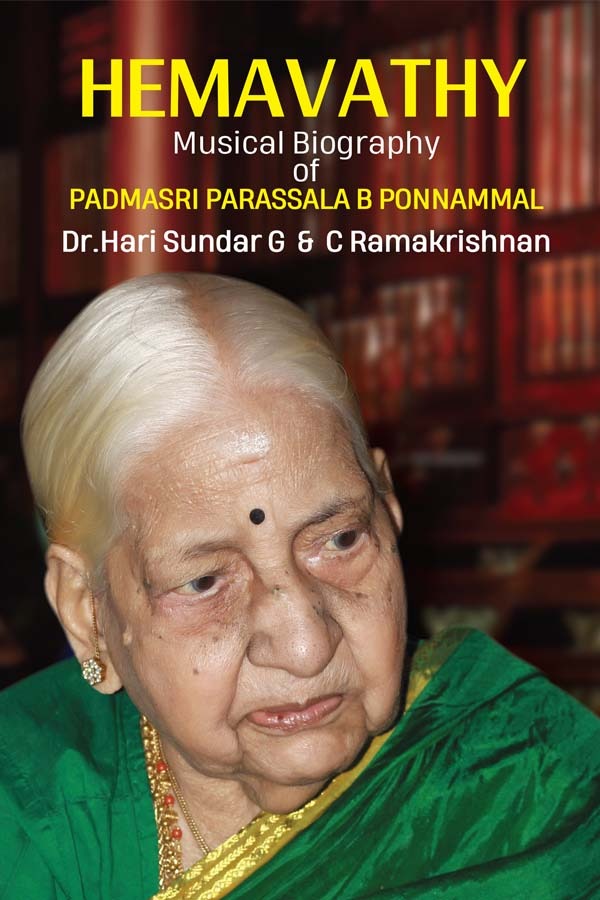A biography of Parassala Ponnammal

Hemavathy, the recently released biography of Parassala Ponnammal, sheds light on the lifelong Kerala- based Carnatic musician academic who became known outside her native state for the first time only at age 82. She went on to get several prestigious awards subsequently, the capstone being the Padma Sri in 2017 – at the age of 93.
This piece appeared in the The Hindu newspaper dated June 17th, 2022 and is part of the Kalpalata Fellowship for Classical Music Writings for 2022.
That the authors, Hari Sundar G. and C. Ramakrishnan, chose Ponnammal as their subject is itself laudable as, often, only the most renowned get written about, particularly in Classical Music. One should note that much of the book was written when Ponnammal was alive (she passed away on 22nd June 2021) and she reviewed the Malayalam manuscript personally. Thus, the biographical aspects of the book can be considered accurate versus books written posthumously, which necessitate reliance on third-party anecdotal accounts. Several of Ponnammal’s own accounts have been meticulously recorded, including experiences with other musicians.
The authors take the reader through the life of a traditional brahmin girl brought up in the sleepy town of Parassala, 34 kilometres from Trivandrum, who through sheer talent, lands up at Swati Tirunal College of Music, the most hallowed ground for Carnatic music in Kerala. Its faculty included Semmangudi Srinivasa Iyer (whose baani Ponnammal followed primarily), N.V. Narayana Bhagavatar and M.A. Kalyanakrishna Bhagavatar. It was at the suggestion of the Principal, Harikesanallur Muthiah Bhagavatar, the authors say, that Ponnammal enrolled in the college. The book refers to renowned artistes like Muthiah Bhagavatar, Chembai Vaidyanatha Bhagavatar, G.N. Balasubramaniam and others, applauding the young girl’s concerts.
Besides Ponnammal’s familiarity with playing the veena, having learned from K.S. Narayanaswamy among others, we also understand she met Papanasam Sivan in person, learning several of his compositions directly from him. She recorded several Ambujam Krishna compositions that she notated whilst Semmangudi tuned them in her presence. These received that composer’s kudos too.
Ponnammal’s induction into the faculty of the very same college she had studied in, the years prior and after, are portrayed as well along with narrations of various concerts she performed.
Prince Aswati Tirunal Rama Varma’s invitation to Ponnammal in 2006 to be the first female ever in the 177 years of the Navaratri Mandapam festival is covered in detail with a photograph of the meeting as well. This pathbreaking occasion announced Ponnammal to the rest of the music loving world. Her self-deprecating acceptance and the preparation for the occasion is explained, giving readers a picture of the thought processes of a musician who appears to have been devoid of pretences.
The book mentions outstation concert offers pouring in after the Navaratri Mandapam program (Prince Rama Varma having disseminated clips on his YouTube channel) beginning with KN Sasikiran for Carnatica and a tour of the US, centred around the Cleveland Aradhana. The Music Academy and Krishna Gana Sabha also honoured Ponnammal with its august awards and the book mentions PS Narayanaswamy commenting that she ought to have been recognised years earlier
While the book covers key aspects of Ponnammal’s personal life, it, creditably, is only in the interests of completeness, living up to its byline of Musical Biography. Understanding that their subject is still largely unheard of, the writers have expended significant effort in detailing Ponnammal’s repertoire, ragam by ragam, elicited through extensive interviews of Ponnammal herself and her students and co-artistes. They also go over noteworthy aspects of her style of singing and what appears to be an exhaustive list of her co-artistes. First person accounts of students and other long associates are appended towards the end of the book.
Those who write biographies do so either because of the marketability of their subject or their own admiration of the protagonist. Here, both authors frankly admit their unvarnished devotion to Ponnammal and her music and their long association with her.
The book’s flow is rather staccato, perhaps due to the tricky nature of two authors attempting to blend individual manuscripts together. The switching between first and third person is confusing at times. Careful proofreading to rectify these aspects could have smoothened the overall narrative, making it read better. However, all are easily fixable for future reprints of what, clearly, is a labour of love for both the music-loving authors. Priced at Rs. 320, the book, in clear, large print, is published by Sarovaram Books.